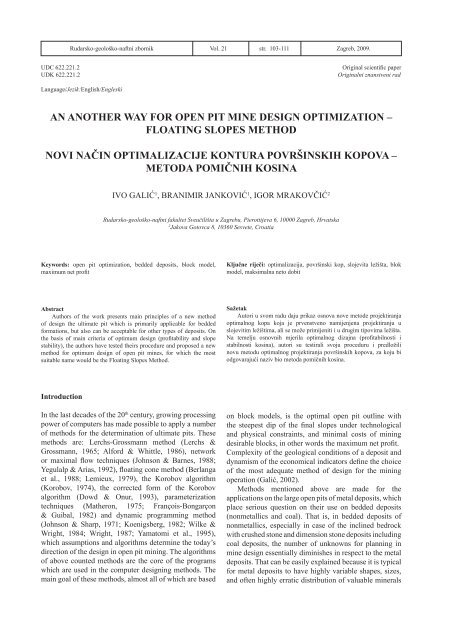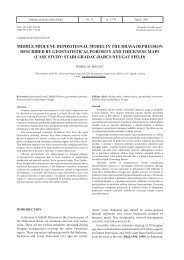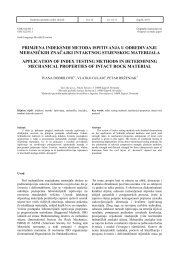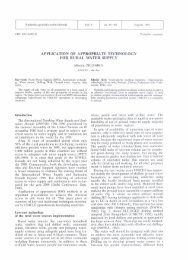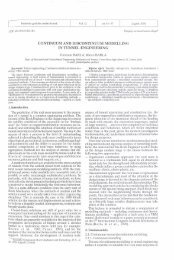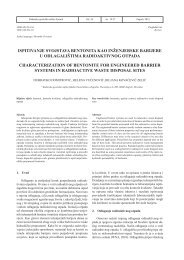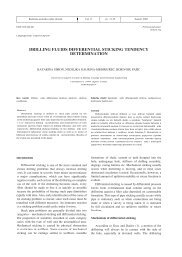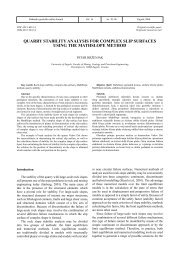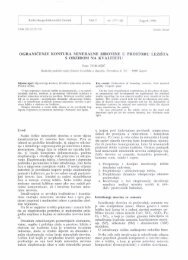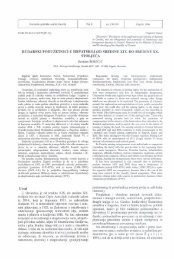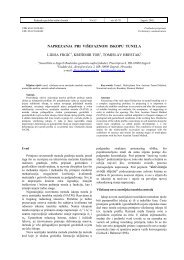AN ANOTHER WAY FOR OPEN PIT MINE DESIGN OPTIMIZATION ...
AN ANOTHER WAY FOR OPEN PIT MINE DESIGN OPTIMIZATION ...
AN ANOTHER WAY FOR OPEN PIT MINE DESIGN OPTIMIZATION ...
You also want an ePaper? Increase the reach of your titles
YUMPU automatically turns print PDFs into web optimized ePapers that Google loves.
Rudarsko-geološko-naftni zbornik Vol. 21 str. 103-111 Zagreb, 2009.UDC 622.221.2UDK 622.221.2Original scientific paperOriginalni znanstveni radLanguage/Jezik:English/Engleski<strong>AN</strong> <strong>AN</strong>OTHER <strong>WAY</strong> <strong>FOR</strong> <strong>OPEN</strong> <strong>PIT</strong> <strong>MINE</strong> <strong>DESIGN</strong> <strong>OPTIMIZATION</strong> –FLOATING SLOPES METHODNOVI NAČIN OPTIMALIZACIJE KONTURA POVRŠINSKIH KOPOVA –METODA POMIČNIH KOSINAIVO GALIĆ 1 , BR<strong>AN</strong>IMIR J<strong>AN</strong>KOVIĆ 1 , IGOR MRAKOVČIĆ 2Rudarsko-geološko-naftni fakultet Sveučilišta u Zagrebu, Pierottijeva 6, 10000 Zagreb, Hrvatska2Jakova Gotovca 8, 10360 Sesvete, CroatiaKeywords: open pit optimization, bedded deposits, block model,maximum net profitKljučne riječi: optimalizacija, površinski kop, slojevita ležišta, blokmodel, maksimalna neto dobitAbstractAuthors of the work presents main principles of a new methodof design the ultimate pit which is primarily applicable for beddedformations, but also can be acceptable for other types of deposits. Onthe basis of main criteria of optimum design (profitability and slopestability), the authors have tested theirs procedure and proposed a newmethod for optimum design of open pit mines, for which the mostsuitable name would be the Floating Slopes Method.SažetakAutori u svom radu daju prikaz osnova nove metode projektiranjaoptimalnog kopa koja je prvenstveno namijenjena projektiranju uslojevitim ležištima, ali se može primijeniti i u drugim tipovima ležišta.Na temelju osnovnih mjerila optimalnog dizajna (profitabilnosti istabilnosti kosina), autori su testirali svoju proceduru i predložilinovu metodu optimalnog projektiranja površinskih kopova, za koju biodgovarajući naziv bio metoda pomičnih kosina.IntroductionIn the last decades of the 20 th century, growing processingpower of computers has made possible to apply a numberof methods for the determination of ultimate pits. Thesemethods are: Lerchs-Grossmann method (Lerchs &Grossmann, 1965; Alford & Whittle, 1986), networkor maximal flow techniques (Johnson & Barnes, 1988;Yegulalp & Arias, 1992), floating cone method (Berlangaet al., 1988; Lemieux, 1979), the Korobov algorithm(Korobov, 1974), the corrected form of the Korobovalgorithm (Dowd & Onur, 1993), parameterizationtechniques (Matheron, 1975; François-Bongarçon& Guibal, 1982) and dynamic programming method(Johnson & Sharp, 1971; Koenigsberg, 1982; Wilke &Wright, 1984; Wright, 1987; Yamatomi et al., 1995),which assumptions and algorithms determine the today’sdirection of the design in open pit mining. The algorithmsof above counted methods are the core of the programswhich are used in the computer designing methods. Themain goal of these methods, almost all of which are basedon block models, is the optimal open pit outline withthe steepest dip of the final slopes under technologicaland physical constraints, and minimal costs of miningdesirable blocks, in other words the maximum net profit.Complexity of the geological conditions of a deposit anddynamism of the economical indicators define the choiceof the most adequate method of design for the miningoperation (Galić, 2002).Methods mentioned above are made for theapplications on the large open pits of metal deposits, whichplace serious question on their use on bedded deposits(nonmetallics and coal). That is, in bedded deposits ofnonmetallics, especially in case of the inclined bedrockwith crushed stone and dimension stone deposits includingcoal deposits, the number of unknowns for planning inmine design essentially diminishes in respect to the metaldeposits. That can be easily explained because it is typicalfor metal deposits to have highly variable shapes, sizes,and often highly erratic distribution of valuable minerals
106Towards the general equation (1), the next equationdetermines the value of open pit, where the block (b i,j,k) isthe lowest in the last slope that would be excavated.L−RL−RSi, j, k= ∑ Ei, j, k⋅( Ct −Cav)(8)Because towards the equation (3), average cost ofmining (C av) can be calculated dividing the total cost ofmining and total quantity of ore excavated, therefore theequation (8) can be transformed in the following shapeS E⎛C⎝∑∑L−RL−RL−Ri, j,ki, j, k= ∑ i, j,k⋅ t−⎜L−REi, j,kwhich after simplification turns into it’s final shape,intended for the computer useS = C ⋅ E − TTL−R L−R L−Ri, j, k t i, j, k i, j,k⎞⎟⎠∑ ∑ (9)where ∑E L-R is the sum of block ore quantities or coali,j,kequivalents if mining coal inside the pit outline, where theblock (b i,j,k) presents the lowest level of the last slope and∑T L-R is the sum of mining costs for blocks inside the piti,j,koutline, where the block (b i,j,k) presents the lowest level ofthe last slope.Addition of ore quantities, mining costs and netvalues of blocks are carried out along slopes, towards theuniversal formula for all three factorsEki,j,k+ bor Ti−2,j+2, kki,j,k+or Pki,j,k= bi,j,k+ bi−1,j+1, k... + bi−r+ 1, j+r−1,k+ bi−r, j+r,k+…..(10)where E k is the sum of ore quantities in the slope, wherei,j,kthe block (b i,j,k) presents the lowest level of the slope, T k i,j,kis the sum of mining costs in the slope, where the block(b i,j,k) presents the lowest level of the slope, P k is the sumi,j,kof net values of blocks in the slope, where the block (b i,j,k)presents the lowest level of the slope, b i,j,kis the belongingvalue (depending what is adding: cost, quantities or profit)in the lowest block of the slope (k n), b i-1,j+1,kis the secondblock of the slope (k n), which is positioned diagonallyabove the block (b i,j,k), b i-2,j+2,kis the third block of theslope (k n),which is positioned diagonally above the block(b i-1,j+1,k), b i-r+1,j+r-1,kis the next to the last block of the slope(k n) (the second block from the surface of the terrain),b i-r,j+r,kis the last-highest block of the slope (k n) (the firstblock from the surface of the terrain) and r is the totalnumber of blocks in the slope (k n) above the block (b i,j,k).Sum of the net values of blocks in one slope presentsprofit for that slope and this value is used for the promptacceptance or the rejection of that specific slope.Net value of any slope inside the pit outline iscalculated from the formulaRud.-geol.-naft. zb., Vol. 21, 2009.I. Galić, B. Janković, I. Mrakovčić: An another way for...k⋅∑ Ei,j ,k−∑kk = CT(11)i,j ,kti, j ,kwhere k i,j,kis the value of slope which begins on the block(b i,j,k).The expression for optimization of the open pit outlinein opposite direction is similar to (7), with reversedindexes.Order of the working phasesProcedure of optimum open pit design using FSMcomprises from more interdependence entirety whoseorder strictly has been determined, for example, it isnot possible to determine the value of blocks while thegeological model hasn’t been made and same model isn’tpartitioned on blocks.Procedure of FSM consists of the following phases:A. Building a geological databaseInside this database, among others, are results of onsiteinvestigations like core drilling, which are the mostimportant. These results provide data about:- heights (depths) of layers that proved to be positive (ore)and accompanying layers,- hanging wall and footwall of high-grade layer(s),- ore quality, etc.B. Construction of the deposit modelThe deposit model is, in fact, 3D interpretation ofgeometrical and geological data. This model has to betransformed into block model, so the main influentialfactors for the ore reserve estimation can be attached toindividual blocks. The summation of blocks provides areserve estimate quantity with analyses of certan cost andearnings data.C. Developing mining databaseThis database includes:1. Data about characteristics of mining equipment:- excavation equipment (the purchase price, hourcapacity, standards of consumption lubricationsand fuel, period of time for amortization),- transport equipment (the purchase price, hourcapacity, standards of consumption lubricationsand fuel, period of time for amortization),- auxiliary equipment (the purchase price, hourcapacity, standards of consumption lubricationsand fuel, period of time for amortization),- water pumps (the purchase price, hour capacity,standards of consumption materials and energy,period of time for amortization).
Rud.-geol.-naft. zb., Vol. 21, 2009.I. Galić, B. Janković, I. Mrakovčić: An another way for...2. Data about the work force:- number of workers,- structure of qualifications and professionaldegrees.3. Data about the excavation technology:- heights of benches (towards the equipmentfor excavation and physical characteristics ofmaterials),- angle of the working bench,- angle of the final slopes,- transportation distances for the ore and waste,- other influential factor of ore and waste.D. Processing of economical factors for theoptimization and attaching them to the mining database.In this phase, on the basis of physical and technologicalinfluential factors, calculations of certain parameters arepreformed. These parameters are attached to every blockb i,j,k, and after that used for the optimization of open pitoutline.E. Optimization of the open pit outlineIn the final part of procedure it is necessary to determinewhich outlines of the pit are economically interesting.There are three possible outlines: optimal, application andthreshold.Determination of the optimal outline of the pit (P O)consists of:- setting up of condition for the optimal outline of the pit(P O) that is C O av < C t ,- calculation of the average cost (C av) and profit for theoptimal open pit (P O),- illustration of the optimal open pit outline in graphicalform.Determination of the application outline of the pit (P A)consists of:107- setting up of condition for the application outline ofthe pit (P A) that is C O ≠ av CA < C , in the function ofav tdetermined purpose, (this case is valid for the optimumopen pit which is to small in order to enclose the allottedobject),- open pit purpose factor subjoins and according to thisobtain open pit outline (for example for the coal depositinfluential factor on the power of the thermoelectricpower plant is quantity of coal and number of years ofpossible production of electricity in the thermoelectricpower plant),- calculation of the average cost (C av) and profit for theapplication open pit (P A),- illustration of the application open pit outline in graphicalform.Determination of the threshold outline of the pit (P T)consists of:- setting up of condition for the threshold outline of the pit(P T) that is C T av ≈ C t ,- calculation of the average cost (C av) and threshold valuefor the open pit (P T).- illustration of the threshold open pit outline in graphicalform.Case studiesHereafter have been analysed and are presented twoexamples of optimum open pit design where have beenset above mentioned conditions: for the optimal outlinecondition is C O < C ; for the threshold outline conditionav tis C T ≈ C . In this examples application outline of the pitav thas been neglected.First ExampleThe first example of optimization has been carriedout from left to right, for the mild inclined strata of coal.The profile of deposit is shown in figure 1, with the netof blocks to which have been subjoined total costs, coalequivalents and unit costs for every block. Table 1 hasbeen fed with mentioned data and by the relation of thesame data optimal and threshold outline of the pit havebeen determined, with the average cost of mining andprofit or loss for every slope.
108Rud.-geol.-naft. zb., Vol. 21, 2009.I. Galić, B. Janković, I. Mrakovčić: An another way for...Figure 1 Determination of optimum open pit outline by the Floating Slopes Method, from left to rightSlika 1. Određivanje optimalne konture površinskog kopa metodom pomičnih kosina s lijeva nadesnoTable 1 Input data and output results for optimization of open pit outline, obtained by floating slopes from left to rightTablica 1. Ulazni podaci i rezultati optimalizacije konture površinskog kopa metodom pomičnih kosina s lijeva nadesnoFigure 2 shows graph of the profit function for the data and results given in table 1.
Rud.-geol.-naft. zb., Vol. 21, 2009.I. Galić, B. Janković, I. Mrakovčić: An another way for...109Figure 2 Ratio of cumulative coal equivalent and profit, obtained by floating slopes from left to rightSlika 2. Odnos kumulativne ogrjevne moći ugljena i dobiti, dobivenog pomicanjem kosina s lijeva nadesnoAlthough the quantity of energy grow, after the point ofmaximum (the optimal outline) the profit falls to the zerovalue (the threshold outline) and after that gets negativesign, in other words presents the loss (end of the model).Second ExampleThe second example of open pit optimization has beencarried out by the synchronous additions of the favourableslopes from left and right of the deposit beginning withits shallowest part, which is presented on figure 3 and hasbeen dealt with in the table 2.Figure 3 Determination of optimum open pit outline by the Floating Slopes Method, with synchronous floating slopes leftwards and rightwardsSlika 3. Određivanje optimalne konture površinskog kopa metodom pomičnih kosina istodobnim pomicanjem kosina nalijevo i nadesno
110Rud.-geol.-naft. zb., Vol. 21, 2009.I. Galić, B. Janković, I. Mrakovčić: An another way for...Table 2 Input data and output results for optimization of open pit outline, obtained by floating slopes floating leftwards and rightwardssimultaneouslyTablica 2. Ulazni podaci i rezultati optimalizacije konture površinskog kopa metodom pomičnih kosina istodobnim pomicanjem kosina nalijevo inadesnoIn the second example, optimal and threshold pitoutline have been clearly shown. The fourth slope (leftand right) presents the outline of optimal open pit, theseventh slope is final in the threshold outline of the pitand the eighth outline is the last in the shown model.Figure 4 Ratio of cumulative coal equivalent and profit, obtained by synchronous floating slopes floating leftwards and rightwards ultaneouslySlika 4. Odnos kumulativne ogrjevne moći ugljena i dobiti, dobivenog istodobnim pomicanjem kosina nalijevo i nadesno
Rud.-geol.-naft. zb., Vol. 21, 2009.I. Galić, B. Janković, I. Mrakovčić: An another way for...ConclusionIn this work, the principles of optimum open pitdesign which is usable primarily for bedded ore bodiesof nonmetallics and coal have been presented. Theprinciple assumptions and equations are given inside thesame entirety (components of algorithm of method) and,in the end, the tests of the method have been preformed.Obtained results gave the first confirmations of principlesthat have been set, expressions and introduced notionsjust as are optimal, application and threshold outlines ofthe pit.In the first example of optimization of open pit outlinethe deposit model with the uneven schedule of coal seemhas been presented, which results in irregularly curveson diagrams (figure 2). By the even schedule of valuablemineral, such as shown case on the second model ofdeposit (figure 4), the uniform curves of growth or fallof profit function are obtained, in other words certainregularity is noticeable.Accepted: 29.10.2009.Received: 16.06.2009.ReferencesAlford, G.G., Whittle, J. (1986): Application of Lerchs-Grossman PitOptimisation to the Design of Open Pit Mines, Open Pit MiningConference, 201-207 pp., Calgary, Canada.Berlanga, J.M., Cardona, R., Ibarra, M.A. (1988): Recursive formulaefor the Floating Cone Algorithm, Mine Planning and EquipmentSelection, 15-25 pp., Rotterdam, Netherlands.Dowd P. A. and Onur A. H. (1993): Open-pit optimization—part 1:optimal open-pit design. Trans. Instn Min. Metall. (Sect. A:Min. industry), 102, 95–104 pp.François-Bongarçon D. and Guibal D. (1982): Algorithms forparameterizing reserves under different geometrical constraints.In Proc. 17th symposium on the application of computers andoperations research in the mineral industries (APCOM: AIME),297–309 pp., New York.111Galić, I. (2002): Mining Design using specialized software, Master’sthesis, Faculty of Mining, geology and Petroleum Engineering,95 pp., Zagreb (in Croatian)Johnson, T.B., Sharp R.W. (1971): A Three-dimensional DynamicProgramming Method for Optimal Ultimate Open Pit Design,Bur. Min. Invest 7553.Johnson T. B. and Barnes R. J. (1988): Application of the maximal flowalgorithm to ultimate pit design. In Levary R. R. ed. Engineeringdesign: better results through operations research methods,518–31, Amsterdam.Koenigsberg, E. (1982): The Optimum Contours of an Open Pit Mine:an Application of Dynamic Programming. 17. APCOM, 274-287 pp., New York.Korobov S. (1974): Method for determining optimal open pit limits(Montreal: Ecole Polytechnique de l’Université de Montréal,Technical report EP74-R-4, 24 pp., Montreal.Lemieux M. (1979): Moving cone optimizing algorithm. In Weiss A. ed.Computer methods for the 80s in the mineral industry, AIME,329–45, New York.Lerchs, H., Grossmann, I.F. (1965): Optimum Design of Open Pit Mines,CIM Bull, 58, 47-54 pp.Matheron G. (1975): Paramétrage des contours optimaux ( Centre deGéostatistique et de Morphologie mathématique), Internalreport N-403; Note géostatistique 128, 54 pp., Fontainebleau.Wilke F. L. and Wright E. A. (1984): Determining the optimal ultimatepit design for hard rock open pit mines using dynamicprogramming. Erzmetall, 37, 139–44.Wright, A. (1987): The Use of Dynamic Programming for Open PitMine Design, Some practical implications. Mining Scienceand Technology, No.4, Elsevier Science Publishers, 97-104 pp.,Netherlands.Yamatomi J. et al. (1995): Selective extraction dynamic cone algorithmfor three-dimensional open pit designs. In Proc. 25th symposiumon the application of computers and operations research in themineral industries (APCOM) (Australasian Institute of Miningand Metallurgy,) 267–74, Brisbane.Yegulalp T. M. and Arias J. A. (1992): A fast algorithm to solve theultimate pit limit problem. In Proc. 23rd symposium on theapplication of computers and operations research in the mineralindustries (APCOM: AIME), 391–7, Littleton, Colorado.


